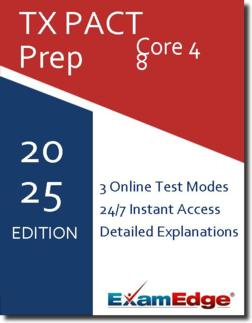TX PACT Core 4–8 (790) Practice Tests & Test Prep by Exam Edge - Topics
Based on 28 Reviews
- Real Exam Simulation: Timed questions and matching content build comfort for your TX PACT Core 4-8 test day.
- Instant, 24/7 Access: Web-based TX PACT Core Subjects Grades 4-8 practice exams with no software needed.
- Clear Explanations: Step-by-step answers and explanations for your TX PACT exam to strengthen understanding.
- Boosted Confidence: Reduces anxiety and improves test-taking skills to ace your TX PACT Core Subjects Grades 4-8 (790).

Understanding the exact breakdown of the TX PACT Core Subjects Grades 4-8 test will help you know what to expect and how to most effectively prepare. The TX PACT Core Subjects Grades 4-8 has 200 multiple-choice questions The exam will be broken down into the sections below:
| TX PACT Core Subjects Grades 4-8 Exam Blueprint | ||
|---|---|---|
| Domain Name | ||
| English Language Arts and Reading | ||
| Reading Process and Comprehension and Reading in Multiple Subject Areas | ||
| Reading Various Text Forms and Analyzing and Interpreting Literature | ||
| English Language Conventions, Composition, Writing Process, and Research | ||
| Modes of Writing | ||
| Oral and Visual Communication | ||
| Mathematics | ||
| Number Sense and Operations | ||
| Algebra and Functions | ||
| Measurement and Geometry | ||
| Statistics, Probability, and Discrete Mathematics | ||
| Social Studies | ||
| History | ||
| Geography and Culture | ||
| Government | ||
| Economics | ||
| Science | ||
| Nature of Science | ||
| Physical Science | ||
| Life Science | ||
| Earth and Space Science | ||


